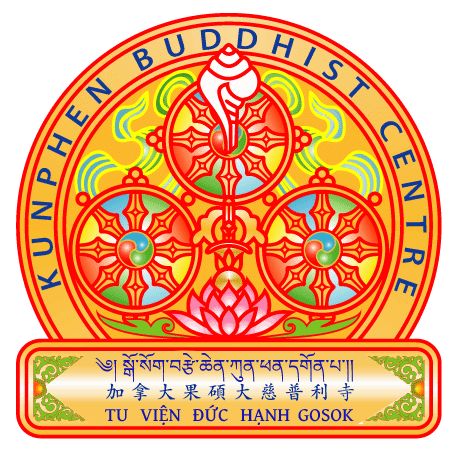Teaching on Dependent Origination Pratityasamutpada
十二緣起支
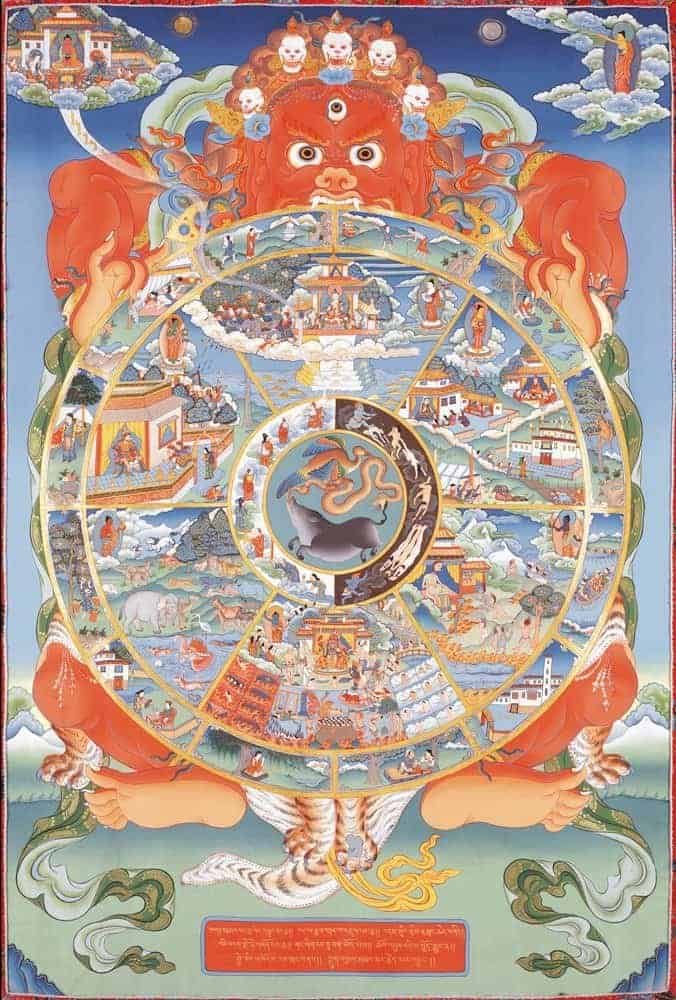
請點這裡進入 “十二緣起支” 中文翻譯
Please click here for the Chinese Translation
Kyabje Gosok Rinpoche
Teaching on The Twelve Links of Dependent Origination, Pratityasamutpada
According to the Sutras, the Meaning of the Twelve Links of Dependent Origination Is: “Because This Exists, That Exists; Because This Arises, That Arises.”
- Ignorance is the starting point.
- From ignorance arises “formation” (the creation of virtuous and non-virtuous karma),
- from formation arises “consciousness” (consciousness being drawn into a mother’s womb due to karmic forces),
- from consciousness arises “name-and-form” (the mental and physical state of the fetus after entering the womb),
- from name-and-form arise the “six sense bases” (the six sense organs—eyes, ears, nose, tongue, body, and mind—developing in the womb),
- from the six sense bases arises “contact” (the interaction between the six sense organs and their respective objects—form, sound, smell, taste, touch, and mental objects),
- from contact arises “feeling” (the three types of sensations—pleasure, pain, and neutrality—arising from contact with external objects),
- from feeling arises “craving” (the psychological activity of clinging to the five desires—wealth, sensual pleasures, fame, food, and sleep—due to attachment to pleasure and aversion to pain),
- from craving arises “grasping” (the intense attachment to and grasping of the desired objects),
- from grasping arises “becoming” (the creation of causes for samsaric existence in this life, leading to rebirth in future lives),
- from becoming arises “birth” (the acquisition of a new body composed of the five aggregates—form, feeling, perception, mental formations, and consciousness—in accordance with the karma of this life), and
- from birth arises “old age and death” (the inevitable progression toward aging and death once one has obtained a defiled body composed of the five aggregates).
The Meaning of the Twelve Links of Dependent Origination and Their Connection to the Four Noble Truths
By following the sequence of the twelve links of dependent origination, practitioners can understand the truth of suffering (dukkha) and the truth of the origin of suffering (samudaya) in the Four Noble Truths. Conversely, by reversing the order, one can gradually eliminate each link through the process of cessation, realize the truth of cessation (nirodha) and the truth of the path (magga), and thus transcend samsara to attain liberation.
The 84,000 teachings taught by the Buddha can all be encompassed within the Four Noble Truths; no teaching falls outside their scope. Therefore, the Four Noble Truths are the central theme of the Buddha’s teachings. When the Buddha first turned the Wheel of Dharma, he explained the meaning of the Four Noble Truths to the five ascetics. Through practicing the Four Noble Truths, any sentient being can progress from the ordinary state to liberation and Buddhahood. Although the Buddha always taught based on the Four Noble Truths, he tailored his teachings to the karmic conditions and capacities of sentient beings, offering instructions of varying depth, subtlety, complexity, and simplicity.
The Twelve Links of Dependent Origination and the Wheel of Life
The Essence of the Four Noble Truths Is so concise that during his lifetime, the Buddha earnestly taught his disciples to practice them. He also instructed his disciples to focus on the Four Noble Truths after his parinirvana and to paint the Wheel of Life (which includes the twelve links of dependent origination) on the gates of monasteries. When laypeople came to the temple to pay homage to the Buddha, the monks were required to explain in detail the meaning of the Wheel of Life, which contains the Four Noble Truths and the Twelve Links of Dependent Origination.
The Wheel of Life
In ancient times, the king of “Yingjian” in central India received precious gifts from the king of “Uddiyana,” a borderland kingdom. Hesitating over what treasure to send in return, he finally decided to gift his most cherished possession—the Wheel of Life depicting the six realms of samsara. Upon seeing the Wheel of Life, the king of Uddiyana experienced profound realization and attained the fruit of Arhatship in this very life.
The Wheel of Life exists in several versions today. The diagram consists of three concentric circles. In the innermost circle are three animals: a rooster (symbolizing attachment), a snake (symbolizing aversion), and a pig (symbolizing ignorance). These represent the root causes that propel sentient beings to endlessly wander in samsara—attachment, aversion, and ignorance.
The second circle depicts the six realms of samsara. Among these, the asuras (anti-gods) share a similar mental continuum with the gods, so sometimes they are grouped together, resulting in the term “five destinies” instead of six.
The figures of the six realms are depicted as ascending or descending, symbolizing how sentient beings can rise to higher realms through virtuous actions or fall into lower realms due to non-virtuous deeds.
The third circle illustrates the twelve links of dependent origination, explaining why and how sentient beings wander in samsara. All three layers are firmly gripped by Yama, the Lord of Death, depicted with a terrifying visage and sharp claws. This symbolizes that all sentient beings, from the highest heaven of the formless realm to the lowest hell of Avici, lack autonomy over their birth and death. They are completely under the dominion of impermanence and Yama.
The First Link: Ignorance
The twelve links of dependent origination begin with ignorance. According to the sutras, ignorance is a non-virtuous and false state of mind that contradicts the true nature of phenomena—emptiness. All phenomena arise temporarily through the aggregation of causes and conditions and manifest their functions accordingly. No phenomenon arises independently without depending on causes and conditions; thus, all phenomena lack inherent existence (emptiness).
The ignorant mindset that clings to phenomena as inherently existent and possessing intrinsic essence contradicts the true nature of reality. This is what is called ignorance.
Additionally, ignorance can also be defined as the deluded mindset that fails to understand the law of cause and effect. According to the Madhyamaka Prasangika view, ignorance refers to misunderstanding the true meaning of the absence of inherent existence in persons (selflessness of persons) and phenomena (selflessness of phenomena). This leads to clinging to the notion that the self (person) and phenomena (such as form, sound, smell, taste, touch, and mental objects, as well as the five aggregates) have inherent existence. This type of ignorance, which clings to the inherent existence of the self and phenomena, is innate rather than being a temporary conceptual fabrication (one of the three natures in Yogacara philosophy, referring to the mistaken belief that phenomena arising dependently have inherent existence). Thus, it is an innate ignorance.
In the Wheel of Life, ignorance is depicted as a blind old woman leaning on a cane. Sentient beings, under the influence of ignorance, fail to understand the true nature of emptiness (the lack of inherent existence) and the principles of karma. Consequently, they continuously create negative karma, causing themselves to wander endlessly in samsara. Thus, innate ignorance serves as the “motivating factor” (intention) that gives rise to attachment, aversion, and ignorance in the mindstream, obscuring the pure nature of sentient beings and compelling them to perpetuate negative actions. In his commentary The Golden Rosary (an explanation of The Ornament of Clear Realizations ), Tsongkhapa distinguishes between two types of ignorance: ignorance regarding the lack of inherent existence of phenomena, termed “ignorance of the causal position,” and ignorance regarding the law of karma, termed “ignorance of the temporal position.” In The Great Treatise on the Stages of the Path to Enlightenment , both aspects are included in the definition of ignorance.
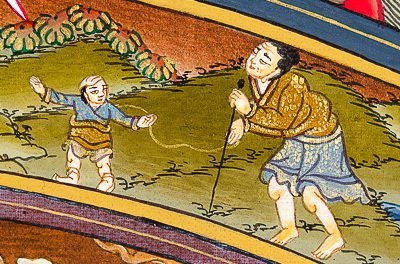
In the Wheel of Life, ignorance is depicted as a blind, hunched-over elderly woman leaning on a cane. This representation conveys that just as a blind person cannot see external objects or discern directions, they easily place themselves in perilous and difficult situations without realizing it, thereby causing themselves to suffer various pains. Similarly, sentient beings, obscured by ignorance, continuously create negative karma, causing them to wander endlessly in samsara and endure immeasurable suffering. Therefore, ignorance is the root of samsara.
The Second Link: Formation (Karma)
The second link is “formation” (karma), which refers to the creation or performance of actions. Due to ignorance as the motivating factor, sentient beings continuously create various types of karma, thereby obtaining a defiled body in future lives. Karma can be categorized into three types: non-virtuous karma, virtuous karma, and immovable karma.
- Sentient beings who are ignorant of the law of cause and effect commit non-virtuous actions, leading to rebirth in the three lower realms (hell, hungry ghosts, animals)—this is non-virtuous karma.
- Those who understand the law of cause and effect but remain ignorant of the true nature of phenomena (emptiness) perform the ten virtuous actions, resulting in rebirth as humans or in the desire realm heavens—this is virtuous karma.
- Those who practice meditative concentration but still lack understanding of emptiness may be reborn in the form or formless realms—this is immovable karma.
In general terms, these describe the rebirth destinations for those who create non-virtuous, virtuous, or immovable karma. Individually, however,
- those who commit non-virtuous karma may be reborn in different hells, hungry ghost realms, or animal forms depending on the specific karma they create.
- Those who perform virtuous karma may be reborn as humans or in one of the six heavens of the desire realm (such as the Heaven of the Four Great Kings, Yama Heaven, or Trayastriṃsa Heaven), with varying lifespans and merits.
- Those who create immovable karma may be reborn in one of the seventeen heavens of the form realm or the four heavens of the formless realm, depending on their specific actions.
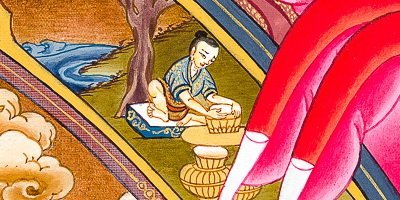
In the Wheel of Life, “formation” is depicted as a potter shaping clay on a wheel. Just as the potter decides the shape and purpose of the pottery, sentient beings determine their future rebirths based on the different types of karma they create.
The Third Link: Consciousness
The third link is “consciousness,” which can be divided into two stages: causal consciousness and resultant consciousness.
Due to ignorance, sentient beings create karma (“formation”), leaving imprints in their mindstream—this is causal consciousness.
These imprints then manifest as resultant consciousness when consciousness enters the mother’s womb in the next life, ripening as the karmic result.
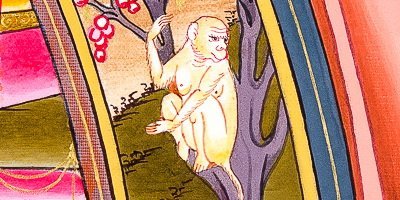
In the Wheel of Life, “consciousness” is depicted as a lively monkey inside an empty house with six windows. The six windows symbolize the six sense bases (eyes, ears, nose, tongue, body, and mind). The restless monkey represents the mind, which interacts with external objects (form, sound, smell, taste, touch, and mental objects) through the six sense bases, generating various pleasant and painful sensations. These sensations then give rise to attachment, aversion, and ignorance, which lead to further karma creation and keep sentient beings trapped in samsara, enduring immense suffering.
Therefore, practitioners seeking liberation from samsara must tame their restless minds, restraining the unruly “monkey mind” and preventing it from causing further trouble.
The Fourth Link: Name and Form
The fourth link is “name and form.” “Name” refers to the four aggregates of feeling, perception, mental formations, and consciousness, while “form” refers to the aggregate of form. In the three realms, only the formless realm lacks the aggregate of form, possessing only the four aggregates of name. In contrast, both the form and desire realms possess all five aggregates. In the context of birth from the womb, “form” represents the initial entry of consciousness into the mother’s womb at the “kalala” stage. Thus, “name and form” collectively represent the five aggregates.
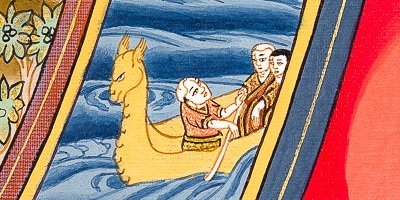
In the Wheel of Life, “name and form” is depicted as a boat being rowed across a river or a tent inhabited by people. Both the boat and the tent require various materials and parts to come together to take shape and function, symbolizing how sentient beings’ bodies are formed through the aggregation of the five aggregates.
The Fifth Link: Six Sense Bases
The fifth link is the “six sense bases,” referring to the maturation of the six sense organs: eyes, ears, nose, tongue, body, and mind. Although the six sense organs of a sentient being in the womb have matured, the corresponding six consciousnesses (eye, ear, nose, tongue, body, and mind consciousness) have not yet fully developed and cannot function. As a result, they cannot interact with external objects (the six sense objects) until the six consciousnesses are complete, giving rise to “contact.” At this stage, the essence of the six sense bases remains unaffected by external conditions.
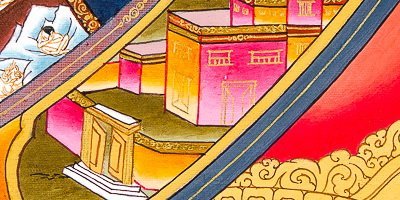
In the Wheel of Life, the “six sense bases” are depicted as an empty house with six windows. The six windows symbolize the six sense organs, while the empty house represents the absence of fully developed six consciousnesses. Both “name and form” and the “six sense bases” represent stages after sentient beings enter the womb and acquire their karmically ripened bodies (the eleventh link—”birth”).
The Sixth Link: Contact
The sixth link is “contact.” At this stage, the six consciousnesses of a sentient being in the womb have fully developed, and through the interaction of the six sense bases (eyes, ears, nose, tongue, body, mind) with their corresponding external objects (form, sound, smell, taste, touch, mental objects), contact arises. At this point, the three elements—sense bases, objects, and consciousness—begin to interact.
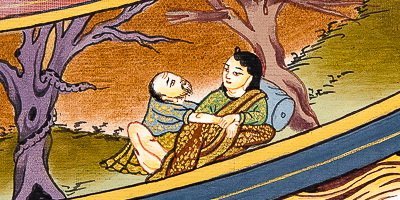
In the Wheel of Life, “contact” is depicted as two people kissing. This symbolizes that contact arises only when the three elements—sense bases, objects, and consciousness—come together to interact.
The Seventh Link: Feeling
The seventh link is “feeling.” As the three elements—sense bases, objects, and consciousness—begin to function, sentient beings experience pleasant feelings toward desirable objects, unpleasant feelings toward undesirable objects, and neutral feelings toward neutral objects.
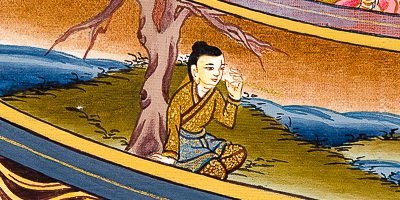
In the Wheel of Life, “feeling” is depicted as an arrow piercing someone’s eye. The eyes are among the most sensitive organs; even a tiny grain of sand entering the eye can cause significant discomfort, let alone an arrow piercing it. This analogy illustrates how the interaction of the six consciousnesses with the six sense bases and six objects produces intense sensations of pleasure, pain, or neutrality.
The Eighth Link: Craving
The eighth link is “craving.” Craving arises from feeling. Sentient beings experience strong sensations of pleasure, pain, or neutrality toward desirable, undesirable, or neutral objects. They develop attachment to pleasant feelings and aversion to unpleasant ones.
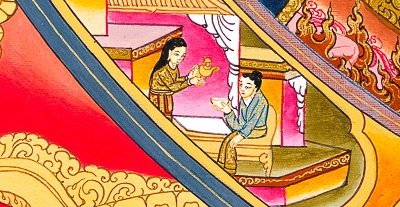
In the Wheel of Life, “craving” is depicted as a drunkard clutching a bottle of alcohol and drinking uncontrollably. The drunkard has become addicted to alcohol and cannot stop drinking. This analogy illustrates how sentient beings develop such a strong attachment to pleasant feelings and aversion to unpleasant ones that they cannot abandon them even for a moment.
The Ninth Link: Grasping
The ninth link is “grasping.” Grasping arises from craving. Due to their strong attachment to pleasant feelings and aversion to unpleasant ones, sentient beings develop an insatiable desire to grasp at the objects associated with these feelings.
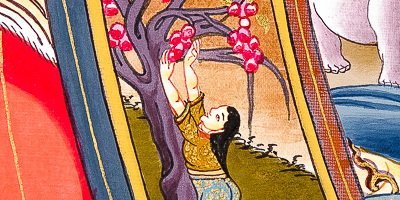
In the Wheel of Life, “grasping” is depicted as a monkey picking fruits from a tree. The monkey greedily plucks fruits indiscriminately, whether ripe or unripe, eats a few bites, discards them, and continues to pick more fruits without satisfaction. This analogy illustrates how sentient beings grasp at pleasurable and painful experiences with insatiable greed.
The Tenth Link: Becoming
The tenth link is “becoming.” Due to ignorance, sentient beings create karma, leaving imprints in their mindstream called “causal consciousness.” Through the nourishment provided by craving and grasping, causal consciousness is propelled by the forces of craving and grasping, ensuring the acquisition of a defiled body in the next life—this is “becoming.” Without the nourishment of craving and grasping, causal consciousness would not result in rebirth.
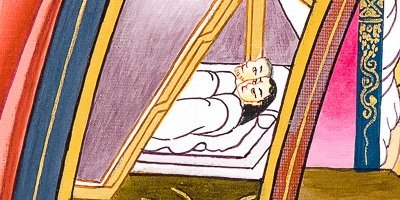
In the Wheel of Life, “becoming” is depicted as a pregnant woman. After conception, a woman must carry the child for ten months before giving birth to a healthy baby. This analogy illustrates how causal consciousness must rely on the supporting conditions of craving and grasping to gradually mature and result in rebirth in the next life.
The Eleventh Link: Birth

The eleventh link is “birth.” Causal consciousness, nourished by craving and grasping, ensures rebirth in the next life. The moment when consciousness first enters the mother’s womb marks the beginning of the “birth” link. In the Wheel of Life, “birth” is depicted as a woman giving birth.
The Twelfth Link: Aging and Death
The twelfth link is “aging and death.” The moment when consciousness first enters the mother’s womb belongs to the “birth” link, while the subsequent moments belong to the “aging and death” link.
“Aging” does not refer to beings older than a certain age but rather to the continuous maturation and transformation of a sentient being’s defiled aggregates. Any change or difference in the aggregates compared to the previous moment constitutes “aging.” After consciousness enters the womb, the aggregates continuously change, thus belonging to the stage of “aging.”
“Death” refers to the consciousness abandoning and separating from the other four aggregates (form, feeling, perception, mental formations), causing the defiled aggregates to disintegrate.
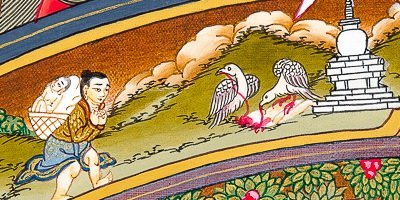
In the Wheel of Life, “aging and death” is depicted as an old man carrying a corpse on his back.
Samsara and Nirvana
Due to the influence of ignorance and formation, sentient beings continuously create karma, causing them to wander endlessly in samsara—between the highest heaven of the formless realm and the lowest hell of the desire realm. They may be reborn as powerful gods like Brahma or Indra, enjoying boundless wealth and glory, or they may fall into the hells, enduring unbearable suffering. Like a bucket tied to a rope for drawing water, they are repeatedly thrown into the well and pulled out, utterly lacking autonomy. The root cause lies in their attachment to samsara. This attachment to samsara is like the rope binding the bucket; without abandoning this attachment, it is impossible to sever the bonds of samsara, let alone attain liberation.
Once, a king asked the Buddha: “If the nature of the world is entirely suffering, then what is ultimate happiness?” The Buddha replied: “Ultimate perfection and happiness lie in nirvana.” The king further asked: “Why is nirvana considered ultimate perfection and happiness?” The Buddha explained: “Nirvana completely extinguishes the conceptual thoughts arising from self-grasping, the afflictions caused by greed, anger, and ignorance, and all the sufferings experienced by sentient beings in the six realms—birth, aging, sickness, death, hunger, heat, and cold. It abides in the true nature of phenomena—emptiness—and attains omniscience, possessing supreme benefit and miraculous abilities. It can effortlessly manifest in various forms and ways according to sentient beings’ karmic conditions and wishes, fulfilling their aspirations and guiding them to liberation. Thus, it is the most ultimate and supreme perfection and happiness.”
Practitioners who have taken refuge in the Buddha and become his followers should strive diligently to attain the perfect state taught by the Buddha. They must generate a strong aspiration to liberate themselves from samsara and completely transcend it, rather than seeking the fleeting pleasures of samsara.
The Four Categories of the Twelve Links of Dependent Origination
Practitioners who wish to attain liberation from samsara must generate a firm renunciation. To develop such renunciation, they must observe and understand the various faults of samsara. To comprehend these faults, they must meditate on the twelve links of dependent origination.
In addition to explaining each link individually, the twelve links of dependent origination can also be classified into four categories based on two levels of causality:
- “causal branches that project”: The “causal branches that project” include ignorance, formation, and causal consciousness.
- “projected branches”: The “projected branches” include resultant consciousness, name and form, six sense bases, contact, and feeling.
- “causal branches that actualize”: The “causal branches that actualize ” include craving, grasping, and becoming.
- “actualized branches”: The “actualized branches” include birth and aging-and-death.
Ignorance is like a farmer, formation is like a seed, and consciousness is like the field. After the farmer plants the seed in the field, it may sprout, bloom, and bear fruit after some time. Similarly, due to ignorance, karma (formation) is planted as causal consciousness in the mindstream, which will later ripen into the results one must experience. This is why these are called the causal branches that project.
After the seed is planted in the field, whether it will sprout, bloom, and bear fruit depends on external conditions such as sunlight, water, and nutrients. Similarly, causal consciousness must rely on the external conditions of craving and grasping to ensure that it propels sentient beings into future lives, maturing the results they must experience. When these results mature, it becomes the “becoming” link. Thus, craving, grasping, and becoming are called the causal branches that actualize.
The virtuous karma created by practitioners through their wholesome actions in this life must be nurtured and strengthened by the external conditions of craving and grasping. Once causal consciousness gains sufficient strength to propel the practitioner into a favorable rebirth in the human or celestial realms, it enters the stage of the “becoming” link.
The transition from the causal branches that project to the projected branches may take one lifetime or many lifetimes to mature. However, once the causal branches that project are nourished by the causal branches that actualize, they will definitely manifest as the actualized branches in the next lifetime. The fruition of these karmic results will not exceed the next life. Therefore, the causal branches that project are the distant causes of the actualized branches, while the causal branches that actualize are the immediate causes.
The links of “birth” and “aging-and-death” are the results produced by causal consciousness being nurtured by craving, grasping, and becoming. Hence, they are called the actualized branches. Birth and aging-and-death will successively give rise to resultant consciousness, name and form, six sense bases, contact, and feeling. Thus, the projected branches are also the results propelled by the causal branches that project and the causal branches that actualize. Since the causal branches that project give rise to causal consciousness, they are called the projected branches.
The causal branches that project are the cause, and the projected branches are the result. The causal branches that actualize are the cause, and the actualized branches are the result. These four categories exhibit a dual relationship of cause and effect.
Through diligent practice, practitioners plant the virtuous causes for rebirth in a pure land within their consciousness. This is the causal branch that projects. After planting these virtuous causes, they make aspirations to be reborn in the pure land. This is the “craving” aspect of the projected branches. Not only do they make these aspirations once but continue to do so repeatedly. This is “grasping.” As the virtuous causes are nurtured by these continuous aspirations, they gradually grow, mature, and gain sufficient strength to ensure rebirth in the pure land. This is “becoming.” After the end of this life, they are reborn in the pure land. This is “birth.” After being reborn in the pure land, the aggregates they experience correspond to resultant consciousness, name and form, six sense bases, contact, and feeling, which are the projected branches.
The Cyclical Process of the Twelve Links and the Path to Cessation
The cyclical process of the twelve links can be completed in as few as two lifetimes or may take three lifetimes, with potential gaps of many lifetimes in between.
For example, a practitioner may create virtuous karma for rebirth in both the human and celestial realms in this life. If craving and grasping for rebirth in the human realm nourish this karma, they will be reborn as a human in the next life. Thus, the virtuous karma for rebirth in the human realm completes its cycle in two lifetimes. However, the virtuous karma for rebirth in the celestial realm may require one or more lifetimes of craving and grasping for celestial rebirth before maturing, leading to rebirth as a celestial being in the third lifetime. In this way, the virtuous karma for celestial rebirth may take many lifetimes to complete its cycle.
Vasubandhu, in the Abhidharmakosa , elaborates extensively on the twelve links of dependent origination. He asserts that through diligent meditation on these links, practitioners can develop firm faith and understanding of the endless nature of samsara.
For instance, by meditating on the twelve links, practitioners can understand that the results they experience in this life are caused by ignorance from past lives, which led to the creation of karma and the planting of causal consciousness. These seeds are then nurtured by craving and grasping, ripening into the results experienced in this life. Such contemplation helps dispel wrong views that deny past lives or the law of karma.
In this life, sentient beings are again driven by ignorance in their mindstream, continuously creating various types of karma. Nourished by craving and grasping, these actions will undoubtedly lead to further wandering in samsara, manifesting as birth and aging-and-death in future lives. Past causes lead to present results, and present craving and grasping continue to mature past causes, resulting in future karmic fruition. The reality of samsara is thus endless. Upon realizing this truth, practitioners should generate a firm renunciation of samsara.
The twelve links can also be categorized into three groups: afflictions (confusion), karma, and suffering. Afflictions include ignorance, craving, and grasping. Karma includes formation and becoming. Suffering includes name and form, six sense bases, contact, feeling, consciousness, birth, and aging-and-death.
Afflictions and karma correspond to the “Truth of the Origin of Suffering” (samudaya) in the Four Noble Truths, while suffering corresponds to the “Truth of Suffering” (dukkha). Furthermore, if all twelve links are considered afflictions, then ignorance, craving, and grasping (afflictions) can be seen as afflictions arising from confusion; formation and becoming (karma) as afflictions arising from karma; and name and form, six sense bases, contact, feeling, consciousness, birth, and aging-and-death (suffering) as afflictions arising from consciousness (fundamental afflictions).
Examining the sequence of the twelve links, practitioners are currently at the stage where karmic results are ripening. The aggregates they possess in this life are the result of karmic seeds planted in past lives under the influence of ignorance, nurtured by craving and grasping, and now maturing into the results experienced in this life. However, throughout countless lifetimes of wandering in samsara, practitioners have created an incalculable number of karmic seeds. If these seeds are nourished by craving and grasping, they will continue to propel practitioners through samsara, subjecting them to various karmic results, and the wheel of samsara will turn endlessly.
Yet, practitioners should reflect: Who causes them to wander endlessly in samsara? The answer is themselves. Just as a car will stop moving if no fuel is added, practitioners, driven by ignorance, continuously create karma and nourish karmic seeds with craving and grasping, thereby fueling the wheel of samsara. Therefore, practitioners must resolve to diligently practice the cessation aspect of the twelve links, purifying the karmic seeds in their consciousness, halting the turning of the wheel of samsara, and attaining liberation.
The root cause of practitioners’ endless wandering in samsara lies in the afflictions of attachment, aversion, and ignorance in their mindstreams. Attachment and aversion arise from ignorance; thus, ignorance is the fundamental cause of samsara.
In the inner circle of the Wheel of Life, there are three animals: a rooster, a snake, and a pig. The rooster symbolizes attachment, the snake symbolizes aversion, and the pig symbolizes ignorance. Since attachment and aversion arise from ignorance, the rooster and snake are depicted as emerging from the mouth of the pig, illustrating this meaning.
The Second Circle of the Wheel of Samsara and Related Depictions
In the Wheel of Samsara, the second circle depicts beings falling and rising, symbolizing how sentient beings, driven by the afflictions of attachment, aversion, and ignorance, continuously create various forms of karma. Those who create virtuous and immovable karma will be reborn in the higher realms of humans and gods in future lives; those who create non-virtuous karma will fall into the lower realms, creating a constant cycle of descent and ascent.
In another style of depiction, the intermediate state (bardo) of beings being reborn in the six realms (five destinies) is represented using black, yellow, and white colors: the three lower realms are depicted in black, the human realm in yellow, and the heavenly realms (including gods and asuras) in white. The lowest level represents the hell realm, with the hungry ghost realm on the right and the animal realm on the left. Above these three lower realms, humans are depicted on the right and gods and asuras on the left.
Sentient beings transmigrating within the three realms and six paths cannot escape the three types of suffering:
- suffering of suffering (obvious pains such as birth, aging, sickness, and death),
- suffering of change (temporary pleasures in samsara that eventually decay and vanish), and
- all-pervasive suffering (the gradual deterioration of the defiled aggregates).
- The suffering of suffering is represented by the three lower realms,
- the suffering of change by humans and the desire realm gods, and
- all-pervasive suffering by the form and formless realm gods.
As long as sentient beings possess defiled aggregates, they cannot escape all-pervasive suffering; thus, no matter where they are reborn within the three realms and six paths, they cannot escape these three types of suffering.
Yama and the Judgment Process
In the center of the hell realm is Yama, the Lord of Death, depicted with a fierce visage, sharp claws, and teeth. In his left hand, he holds a mirror, symbolizing his ability to clearly perceive the karma created by sentient beings; in his right hand, he holds two tally sticks, one black and one white, used to meticulously record the white karma (virtuous actions, meritorious deeds) and black karma (non-virtuous actions, demeritorious deeds) of beings. To ensure auspicious causes and conditions, the white tally stick is usually depicted as longer than the black one.
Guidance by Deities of Virtue and Vice
At the time of birth, every sentient being is accompanied by an innate deity of virtue (a god) and an innate deity of vice (a demon). Virtuous actions correspond to the deity of virtue, while non-virtuous actions correspond to the deity of vice. When a sentient being approaches death, they are led by these deities before Yama. In front of Yama are many black and white stones. As Yama examines the karma of beings through the karmic mirror, if the karma is virtuous, the deity of virtue picks up a white stone and places it before the being; if the karma is non-virtuous, the deity of vice picks up a black stone and places it before the being, thus weighing the virtuous and non-virtuous karma of the being. This is the situation faced by beings after death. After Yama completes his examination of the karma, if the virtuous karma outweighs the non-virtuous, he hands the white tally stick to the deity of virtue, who guides the being to a favorable rebirth in the human or heavenly realms. If the non-virtuous karma is greater, he hands the black tally stick to the deity of vice, who drags the being into the lower realms.
Other Symbols in the Wheel of Samsara
In the Wheel of Samsara, between the inner circle depicting the rooster, snake, and pig and the second circle depicting the five destinies, images of the deities of virtue and vice are drawn. The deity of virtue is positioned in the upper left, symbolizing the guidance of beings with more virtuous karma to favorable rebirths in the human or heavenly realms. The deity of vice is positioned in the lower right, symbolizing the dragging of beings with more non-virtuous karma into the lower realms.
Additionally, within the five destinies, there are depictions of monks practicing pure conduct, symbolizing that maintaining pure conduct is also a cause for favorable rebirth. Within the heavenly realms, scenes of gods and asuras in conflict are depicted, symbolizing that even gods and asuras experience much suffering. To ensure auspicious causes and conditions, these scenes are typically depicted with the gods victorious over the asuras.
In the human realm, scenes of people joyfully welcoming new life, patients receiving treatment, and the elderly walking with canes are depicted, symbolizing the unavoidable sufferings of birth, aging, sickness, and death inherent to human existence.
As for the sufferings of the hot hells, cold hells, neighboring hells, hungry ghosts, and animals in the three lower realms, they can only be symbolically represented and not fully detailed.
The Relationship Between the Wheel of Samsara and the Twelve Links of Dependent Origination
The Wheel of Samsara illustrates that sentient beings in the three realms, from the highest heaven of the formless realm to the lowest hell of Avici, endlessly transmigrate within the six paths (five destinies). The root cause of this transmigration lies in the afflictions and karma within the mindstream of sentient beings, which are encompassed within the twelve links of dependent origination. Thus, all sentient beings in the three realms are bound by the twelve links and cannot escape.
The Method to Halt Samsara: The Cessation Process
Practitioners can understand the causes and faults of samsara through the causal relationships between the twelve links. The causes of samsara (afflictions and karma) correspond to the Truth of the Origin of Suffering (samudaya), while its faults correspond to the Truth of Suffering (dukkha).
Having understood the faults and root causes of samsara, one must find a way to halt it and attain liberation.
The method to halt samsara involves reversing the order of the twelve links—starting from aging-and-death, birth, becoming, grasping, craving, feeling, contact, name and form, six sense bases, consciousness, formation, and ignorance—and progressively negating each link. Through practicing the cessation process (the Truth of the Path, magga), practitioners purify the karma and afflictions in their mindstreams, thereby truly halting samsara and attaining liberation (the Truth of Cessation, nirodha).
The Symbolism of the Buddha Image and Nirvana
In the upper right corner of the Wheel of Samsara, there is a majestic standing image of the Buddha, radiating countless rays of light. His right hand points toward a luminous, full moon-like glow, symbolizing that practitioners wish to cease the endless wandering in samsara and hope to completely end the boundless suffering of samsara, attaining the ultimate happiness and perfection of nirvana.
The radiant, moon-like glow symbolizes nirvana, and the Buddha’s gesture of pointing toward the light signifies that the only way to attain nirvana is by following the Buddha’s teachings; there is no other path!
Below the moon-like glow is a scroll of scripture, symbolizing that practitioners must diligently practice the various stages of the path taught by the Buddha in order to attain the sublime state of nirvana.
The Reality of Samsara and the Mind of Renunciation
The Wheel of Samsara explains the reality of samsara, enabling practitioners to understand its causes and faults and how to attain the sublime state of nirvana through practicing the cessation process, thereby encapsulating the meaning of the Four Noble Truths. Furthermore, the twelve links can be divided into two categories: afflictions and purity. The causes of samsara (the Truth of the Origin of Suffering) and its faults (the Truth of Suffering) belong to the category of afflictions, while attaining nirvana (the Truth of Cessation) through practicing the cessation process (the Truth of the Path) belongs to the category of purity.
Practitioners should reflect thus: In the vast ocean of samsaric existence, they have drifted for countless eons. Although fortunate to have attained a human body in this life, adversities and suffering have never ceased. If they fail to seize this precious opportunity of possessing a human body and encountering the Dharma, and instead squander their lives, they will inevitably fall into the three lower realms in future lives, enduring boundless suffering—a vicious cycle that is profoundly tragic and terrifying!
Practitioners should reflect in this way to generate a firm mind of renunciation, aspiring to attain liberation, thereby halting the wheel of samsara and achieving the ultimate happiness and perfection of nirvana.
The above is a translation from our Chinese webpage, based on original Tibetan teachings.

